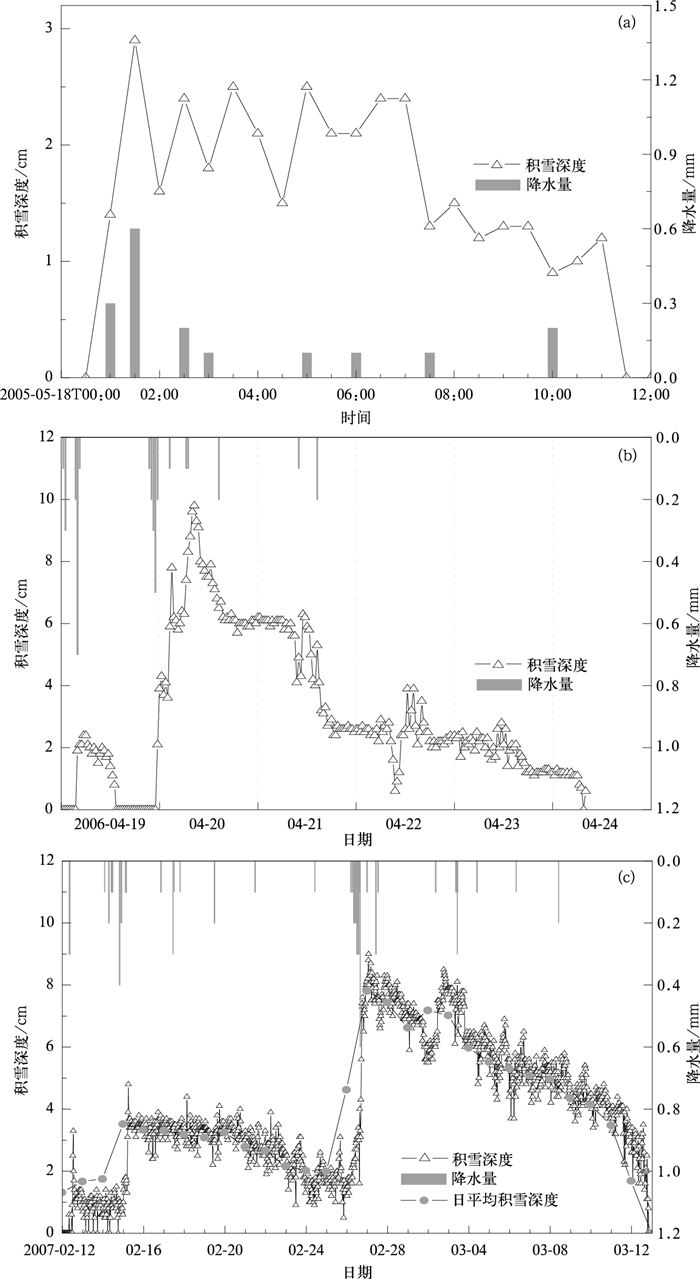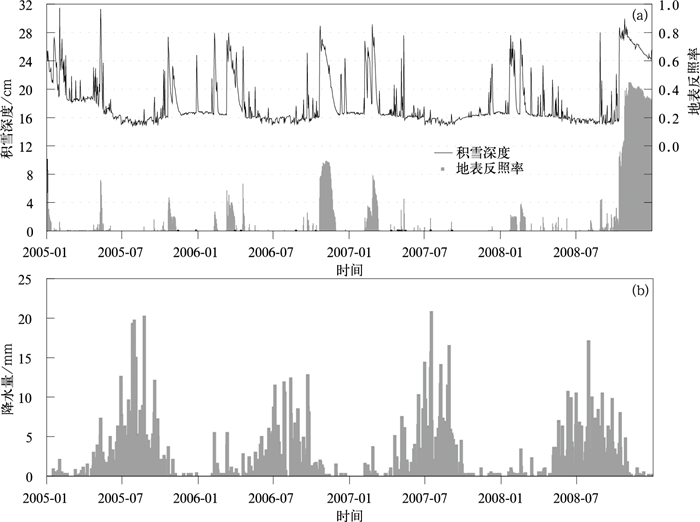The Evaluation of SR-50 for Snow Depth Measurements at Tanggula Area
-
摘要: 利用2004年5月以来超声雪深传感器SR-50在青藏高原唐古拉综合监测场获取的实时积雪资料和相关气象数据,评估了SR-50在青藏高原积雪监测中的性能和作用,并对青藏高原腹地多年冻土区积雪变化特征进行初步分析。结果表明:超声雪深传感器SR-50对不同时间尺度的地表积雪过程均有较好的监测能力。监测数据清晰地显示唐古拉地区地表积雪深度在夜间相对稳定、在日间迅速降低的特点。唐古拉地区平均年积雪日数为82 d,各月均有地表积雪出现,但夏季的地表积雪较少且持续时间很短。该地区地表积雪总体上呈厚度较薄、消融较快、持续时间较短的特点。2005—2008年该地区瞬时最大积雪深度为22 cm,日平均积雪深度小于5 cm日数占总积雪日数的71.58%。
-
关键词:
- 唐古拉地区;
- 积雪深度;
- 超声雪深传感器SR-50
Abstract: Snow cover, an important component of the cryosphere, has a profound impact on the surface and atmospheric heat conditions, ecological environment and water resources due to its special characteristics such as high reflectivity, high emissivity and low thermal conductivity. Because of its altitude and topography, the Tibet Plateau becomes the largest region with snow cover in the Northern Hemisphere. Snow cover data commonly used in scientific research is mostly collected by satellite, microwave snow monitoring data or the daily snow depth measurements from meteorological observation stations. These data show a disadvantage of insufficient time resolution when studying the detailed processes of snow cover and the impacts.Ultrasonic snow depth sensor SR-50, developed by Campbell Company, is an advanced observation instrument for snow depth. Using the measurements obtained by SR-50 at Tanggula (TGL) comprehensive monitoring site in the permafrost region on the Tibet Plateau, the evaluation of SR-50 for snow depth measurements is introduced and the characteristics of snow cover in permafrost regions are analyzed.The results indicate that SR-50 shows a very good ability in monitoring the real-time snow depth on different time scales. SR-50 could capture the detailed processes of surface snow cover, and gain real-time snow depth data. The processes of snow falling and melting could be well understood through the varieties of snow depth. The data of snow cover have a very important role in the study of snow cover processes and its impacts on land surface processes in permafrost regions. It shows that surface snow cover appeared in each month throughout the year in the target regions on the Tibet Plateau. The snow covered days mainly concentrated in the winter half year. In February, March, October and November, the number of snow covered days is larger, but in June, July and August it is much smaller. Overall, the snow depth at TGL site is much thinner compared with that of high latitude regions, and the duration of snow cover is much shorter due to the faster melting speed brought by much higher solar radiation. From 2005 to 2008, the instantaneous maximum snow depth of the region is 22 cm and the days with mean daily snow depth below 5 cm accounts for 71.58% of all snow days. In addition, recent raingauge record of solid precipitation is generally much lower than the actual situation because wind and other factors affect its capturing rate. The observations of snow depth by SR-50 provide a valuable dataset for revising the solid precipitation on the Tibet Plateau.-
Key words:
- Tanggula Area;
- snow depth;
- SR-50 sensor
-
表 1 2005—2008年逐月及年积雪日数 (单位:d)
Table 1 Monthly and annual numbers of snow-covered days at TGL site from 2005 to 2008(unit:d)
年份 1月 2月 3月 4月 5月 6月 7月 8月 9月 10月 11月 12月 年积雪日数* 2005 19 8 13 12 20 3 0 1 4 16 10 2 2006 0 10 21 11 6 1 1 1 7 14 30 2 82 2007 0 21 13 5 8 4 4 1 3 0 0 5 106 2008 7 22 4 4 7 1 2 11 21 31 30 31 58 注:*按年度 (北半球是从前一年7月1日至当年6月30日) 统计全年的积雪日数。 表 2 2005—2008年TGL日平均积雪深度分布
Table 2 Distribution of daily average snow depth at TGL site from 2005 to 2008
积雪深度/cm 积雪日数/d 所占比例/% > 10 77 17.23 ≥5 173 28.42 < 5 320 71.58 < 3 276 61.74 < 1 162 36.24 -
[1] 吴国雄.我国青藏高原气候动力学研究进展.第四纪研究, 2004, 24(1):1-9. http://www.cnki.com.cn/Article/CJFDTOTAL-DSJJ200401000.htm [2] 叶笃正, 高由禧.青藏高原气象学.北京:科学出版社, 1979:276-316. http://www.cnki.com.cn/Article/CJFDTOTAL-SYQY201603027.htm [3] 吴国雄, 毛江玉, 段安民, 等.青藏高原影响亚洲夏季气候研究的最新进展.气象学报, 2004, 62(5):528-540. doi: 10.11676/qxxb2004.054 [4] Barnett T P, Dumenil L, Schlese U, et al.The effect of Eurasian snow cover on regional and global climate variations.J Atmos Sci, 1989, 46(5):661-686. doi: 10.1175/1520-0469(1989)046<0661:TEOESC>2.0.CO;2 [5] 李培基.中国西部积雪变化特征.地理学报, 1993, 48(6):505-515. http://www.cnki.com.cn/Article/CJFDTOTAL-DLXB199306003.htm [6] 韦志刚, 黄荣辉, 陈文, 等.青藏高原地面站积雪的空间分布和年代际变化特征.大气科学, 2002, 26(4):496-508. http://www.cnki.com.cn/Article/CJFDTOTAL-DQXK200204006.htm [7] 张东, 余志豪.青藏高原冬春季积雪异常与我国夏季低温的关系.气象科技, 1999, 19(1):1-8. http://www.cnki.com.cn/Article/CJFDTOTAL-QXKX199901000.htm [8] 韦志刚, 吕世华.青藏高原积雪的分布特征及其对地面反照率的影响.高原气象, 1995, 14(1):63-73. http://www.cnki.com.cn/Article/CJFDTOTAL-GYQX501.007.htm [9] 张顺利, 陶诗言.青藏高原积雪对亚洲夏季风影响的诊断及数值研究.大气科学, 2002, 25(2):372-390. http://www.cnki.com.cn/Article/CJFDTOTAL-DQXK200103008.htm [10] 沈志宝.藏北地区冬季降雪对地面反照率的影响.高原气象, 1996, 15(2):165-171. http://www.cnki.com.cn/Article/CJFDTOTAL-GYQX602.004.htm [11] 徐国昌, 李珊.青藏高原雪盖异常对我国环流和降水的影响.应用气象学报, 1994, 5(2):62-67. http://qikan.camscma.cn/jams/ch/reader/view_abstract.aspx?file_no=19940111&flag=1 [12] 韦志刚, 罗四维, 董文杰, 等.青藏高原积雪资料分析及其与我国夏季降水的关系.应用气象学报, 1998, 9(增刊Ⅰ):39-46. http://www.cnki.com.cn/Article/CJFDTOTAL-YYQX8S1.005.htm [13] 李庆, 陈月娟.青藏高原积雪异常对亚洲夏季风气候的影响.解放军理工大学学报:自然科学版, 2006, 7(6):605-612. http://www.cnki.com.cn/Article/CJFDTOTAL-JFJL200606019.htm [14] Khandekar M L.Eurasian snow cover, Indian monsoon and El Nino/Southern Oscilation—A synthesis.Atmosphere Ocean, 1991, 29(4):636-647. doi: 10.1080/07055900.1991.9649422 [15] Cohen J, Rind D.The effect of snow cover on the climate.J Clim, 1991, 4:689-706. doi: 10.1175/1520-0442(1991)004<0689:TEOSCO>2.0.CO;2 [16] Campbell J L, Mitchell M J, Groffman P M, et al.Winter in northeastern North America:A critical period for ecological processes.Frontiers in Ecology and the Environment, 2005, 3(6):314-322. doi: 10.1890/1540-9295(2005)003[0314:WINNAA]2.0.CO;2 [17] 钟爱华, 严华生, 李跃清, 等.青藏高原积雪异常与大气环流异常间关系分析.应用气象学报, 2010, 21(1):37-46. doi: 10.11898/1001-7313.20100105 [18] 秦大河, 效存德, 丁永建, 等.国际冰冻圈研究动态和我国冰冻圈研究的现状与展望.应用气象学报, 2006, 17(6):649-656. doi: 10.11898/1001-7313.20060602 [19] 时兴合, 李凤霞, 扎西才让, 等.1961—2004年青海积雪及雪灾变化.应用气象学报, 2006, 17(3):376-382. http://qikan.camscma.cn/jams/ch/reader/view_abstract.aspx?file_no=20060364&flag=1 [20] 郑照军, 刘玉洁, 张炳川.中国地区冬季积雪遥感监测方法改进.应用气象学报, 2004, 15(增刊):75-84. http://www.cnki.com.cn/Article/CJFDTOTAL-YYQX2004S1011.htm [21] 李晓静, 刘玉洁, 朱小祥, 等.利用SSM/I数据判识我国及周边地区雪盖.应用气象学报, 2007, 18(1):12-20. doi: 10.11898/1001-7313.20070103 [22] 肖瑶, 赵林, 李韧, 姚济敏.CoLM模型在高原多年冻土区的单点模拟适用性.山地学报, 2011, 29(5):633-640. http://www.cnki.com.cn/Article/CJFDTOTAL-SDYA201105018.htm [23] Ryan W A, Doesken N J, Fassnacht S R.Evaluation of ultrasonic snow depth sensors for US snow measurements.J Atmos Ocean Technol, 2008, 25(5):667-684. doi: 10.1175/2007JTECHA947.1 [24] Brazenec W A.Evaluation of Ultrasonic Snow Depth Sensors for Automated Surface Observing Systems (ASOS).Colorado:Colorado State University, 2005. [25] Campbell Scientific Inc.Campbell Scientific Online SR-50 Manual.[2005-03-04].http://ftp.campbellsci.com/pub/outgoing/anuals/sr50.pdf. [26] 孙菽芬.陆面过程的物理、生化机理和参数化模型.北京:气象出版社, 2005. http://www.cnki.com.cn/Article/CJFDTOTAL-SYQY201603027.htm -


 设为首页
设为首页 加入收藏
加入收藏



 下载:
下载:



